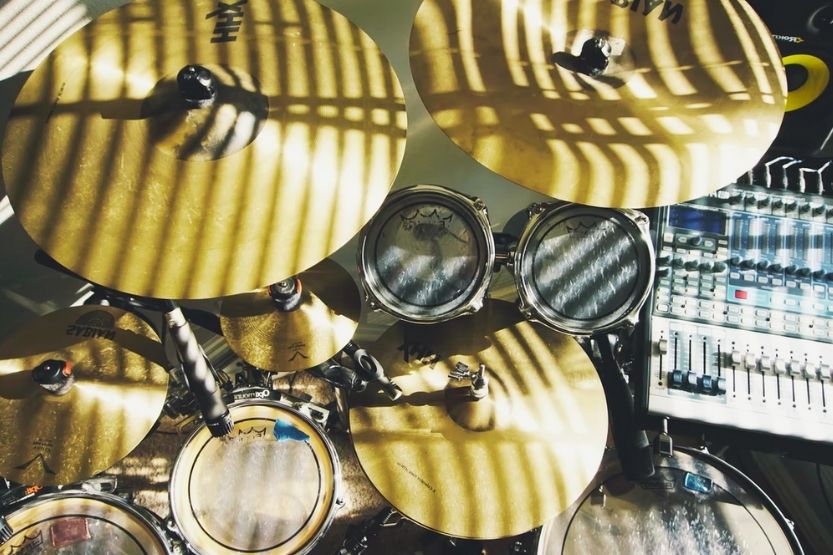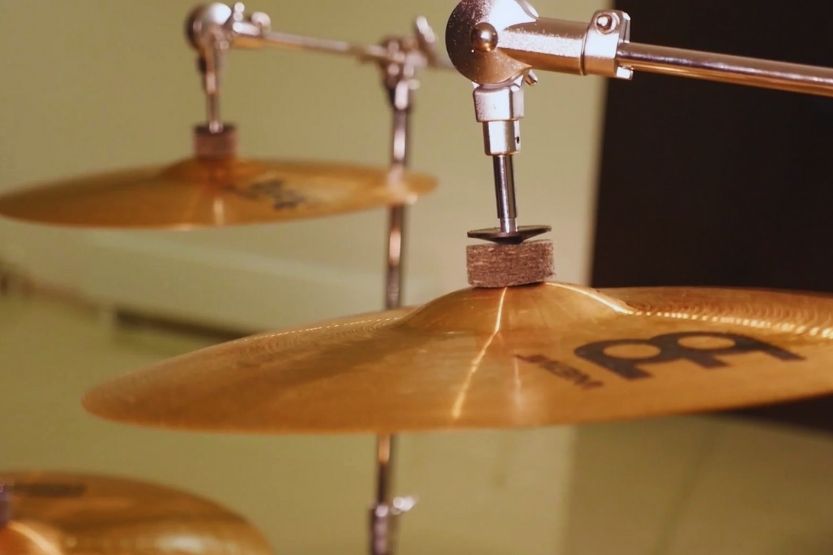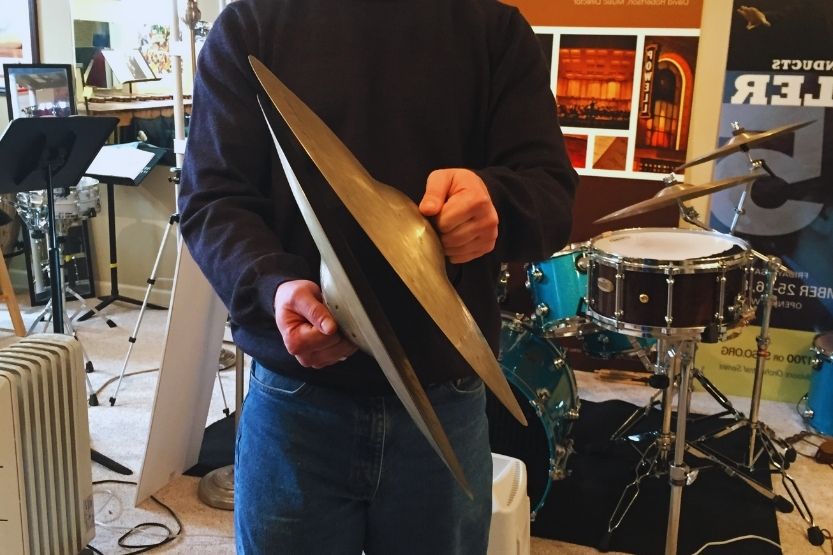While they may not be as popular as ride and hi-hat cymbals, crash cymbals are vital components of a complete drum set. From orchestras to marching bands, they are essential percussion instruments that add rising swells and sharp pings to your music.
Crash cymbals are percussion instruments that you can use as a standing component of a drum set or play by hand. It produces thin and bright sounds, often used for transitioning between sections, at the end of the song, or during drum solos. Compared to a ride cymbal, crash cymbals are smaller and have more emphasis on the treble.
Read on to learn more about crash cymbals, including tips on using them like a pro. To add, we’ll also compare it with ride cymbals.
Also, we hope you find the links here useful. We may get a commission if you purchase something through a link on this page, so thank you!
Crash Cymbal Explained

Common in Marching and Military Bands
This percussion instrument is common in marching, military, concert bands, orchestras, and percussion ensembles. Users can play the crash cymbals in pairs, or you can also mount it on a stand and use drumsticks.
Thickness Varies
The thickness of crash cymbals varies from one manufacturer to another. However, it has a thin edge in most cases. Some may be paper-thin, and others are quite heavy. The typical size ranges from 14 to 18 inches. Being small also affects the sound quality that it can create, but it does not make it any inferior compared to its bigger counterparts.
Not Used as Frequently as Other Cymbals
Crash cymbals are not used as frequently as their other counterparts, specifically hi-hat and ride cymbals. Most drummers use crash cymbals only when they are transitioning between sections. It is also common to play such during drum solos or to conclude a song.
Origin Is Uncertain
The origin of crash cymbals is uncertain, but one thing is sure – it is relatively new compared to other cymbals. They were first played in Turkey in the 18th-century. With that, today’s leading suppliers of this instrument are also from Turkey.
Two Main Types of Crash Cymbals
Two main types of crash cymbals:
- A pair that stands up as a part of a drum kit. You will play them using drumsticks; and
- A pair that you hold in your hand and have to crash to make a sound.
While a drum set can have different cymbals, crash cymbals are often the first to crack and give up. It has fractures on the edges and across the bow because of repetitive and aggressive striking. If you do not treat the cracks, lathe grooves will appear and eventually damage the entire cymbals.
How to Play Crash Cymbals
Now that you have a primer of crash cymbals are, we’ll share some tips on how you can play it like an expert. It can be intimidating, but it is easy to master the tricks with the things mentioned below:
1. Start with the Right Cymbals
Click here to see this Zildjian Planet Z Crash Cymbal (ZP16C) on Amazon.
Click here to see this Meinl Cymbals 14” Crash on Amazon.
Before you learn the techniques, one of the most important is to have the right crash cymbals. Buy one from some of the most trusted names in the global market, such as Sabian, Zildjian, Paiste, and Meinl Percussion. Consider other factors, such as how thin the crash cymbals are and how they sound.
2. Position the Cymbals Properly
The right positioning of crash cymbals greatly impacts the way you play. We suggest putting them on your non-dominant side. Meaning, if you are right-handed, then the cymbals should be on your left. This makes them easily accessible while making sure that your hands are playing naturally.
3. Strike the Cymbal at the Right Place
Most beginners hit the cymbals without minding where the sticks crash. Aim to strike the cymbals near the edge. As a result, it has a more resonant and louder sound. If you hit near the center, then the music will be more muted. Although, there are instances when the latter is necessary.
4. Know How to Use the Sticks
It is not just all about where you strike the cymbals. Another thing that matters is which part of the drumsticks hit the surface. Ideally, you should hit with the shaft. If you hit the crash cymbals with the tip, you won’t create much volume.
Worse, it easily damages the sticks. Nonetheless, for a softer sound, such as in jazz, it makes sense to use the tip, but you shouldn’t hit too hard.
5. Master the Right Way of Holding the Cymbals
As you know by now, there are two types of crash cymbals. One is a pair you mount on a stand as part of a drum kit, and the other is a pair you hold. In the latter case, your thumb and index finger should curl on the strap near the bell of the crash cymbals. The strap should lay on the palm. Meanwhile, the three other fingers should wrap on the strap.
Again, what are crash cymbals? A crash cymbal produces a loud and sharp crash, which provides an accent to music. Usually, a drummer playing rock music hits different crash cymbals in a kit to give a loud accent.
Crash Cymbal vs Ride Cymbal

Click here to see this Sabian SBR1811 SBR Series Pure Brass 18-Inch Crash/Ride Cymbal on Amazon.
Crash cymbal and ride cymbal are two of the most popular types of cymbals. For most people, they may look the same. Nonetheless, as you examine closer, you will realize that there are significant differences, including those that we’ll be talking about below:
1. Size
Crash cymbals generally have a diameter of 14 to 20 inches. The most common, however, ranges from 16 to 18 inches. Meanwhile, most sound engineers prefer crash cymbals with a smaller diameter as they generally sound better during recording.
On the other hand, ride cymbals often have a diameter of 20 to 22 inches. Even one diameter can make a huge difference in the overall sound quality, including cymbal wash and feel.
2. Sound
For the uninitiated, it is easy to assume that both cymbals sound alike. However, for those who have trained ears, the differences are obvious. You need to match the choice of cymbals to the specific application or the sound you wish to make.
Crash cymbals have a thinner sound. One of the reasons for the latter is its smaller diameter. The thinner the crash cymbals are, the more treble it makes. You will also find some that are marketed as paper-thin cymbals. They have no mid-frequencies and will appear quieter to the human ears.
3. Uses
Based on the song’s genre, the two cymbals are also different regarding where and how you use them. Because crash cymbals have a brighter sound, they are not often for steady sound.
Ride cymbals are for core grooves, such as jazz. Meanwhile, crash cymbals are not for making grooves. In ride cymbals, the pattern is a consistent rhythm moving forward with the music.
4. Playing Surfaces
When using cymbals, you must understand the playing surfaces. It will dictate the specific parts of the surface that you should be hitting to generate the necessary sound. If you hit on the wrong places, then you are compromising the output.
Both can be played on the bow, bell, and edge. The difference does not lie in the type of cymbal but in the sound you want to create. For instance, whether you want it loud or soft will dictate the right playing surface.
Other Types of Cymbals You Need to Know
While we are already on the subject of crash and ride cymbals, here are the other types of cymbals that you will find:
1. Hi-Hat Cymbals
It is a pair of cymbals sitting together on a stand, which you will control through a foot pedal. It produces a soft and crisp sound, making it perfect for steady patterns.
2. Splash Cymbals
Like crash cymbals, they add accents to the music. It is also for adding certain effects to complement the drums. Being small and thin, they can produce short and sharp sounds.
3. China Cymbals
They look like Chinese gongs, and hence, the name. It has a cylindrical bell and upturned edge, making it easy to recognize. It has distinctive trashy and explosive sounds.
Crash Cymbals Care and Maintenance

Over time, crash cymbals are prone to wear and tear, mainly if you use them often. Dirt can accumulate, and dents will start to show. To prolong its lifespan and preserve the peak functionality, here are some of the best things to do:
1. Hit the Cymbal Cautiously
A lot of people may end up being aggressive when they are hitting cymbals. After all, it is easy to be carried away by the energy of the song. Nonetheless, it can damage the surface, especially if it is thin and fragile. So, play with caution and hit the cymbals at the right angle to avoid them from easily breaking.
2. Carry and Store Properly
From transporting to storing the crash cymbals, make sure that it has full protection. For instance, it will benefit from having a protective case or padded bag, which will prevent damage when bumping on a solid surface. Such will also protect against dust and dirt, among other things that can cause premature wear.
3. Mount the Cymbals Correctly
Taking care of your crash cymbals also entails the need to position them correctly. Over-tightening the cymbals is a big no as it exerts unnecessary pressure that can result in irreversible damage. Loosen it a bit, so there is enough room to flex and swing on the stand.
4. Use a Cymbal Cleaner
Do not just use any cleaning product as it can have harsh ingredients that can do more harm than good. Instead, look for one marketed as a cymbal cleaner. Apply it on the grooves using a microfiber cloth, making sure that you cover all areas. A pea-sized amount and thin coating will be enough. Finish by applying a polisher to keep the finish looking good.
5. Dry the Crash Cymbals
Once you are done cleaning the crash cymbals, let them dry thoroughly before re-assembly or storage. Otherwise, moisture can be present, which metal will hate. The finish can easily deteriorate if you do not dry the cymbals.
Click here to see these Facmogu 23PCS Cymbal Replacement Accessories on Amazon.
Conclusion – Crash Cymbal Explained
Crash cymbals are great percussion instruments either as part of a drum kit or played by hand. Originally from Turkey, it is currently used in marching bands and orchestras. For beginners, playing crash cymbals requires striking at the right surface and using the right portion of the drumsticks for optimal sound.
Do not confuse crash cymbals with ride cymbals. One of the most common differences is the size. The diameter of crash cymbals is often smaller, which is typically anywhere from 14 to 20 inches. Meanwhile, ride cymbals have a diameter of 20 to 22 inches. Due to their small size, crash cymbals can also produce brighter sounds that emphasize treble more.
Related reading:
Best Electronic Drum Set / Kit [Reviews]
What Is the Easiest Instrument to Learn? [10 Easy Musical Instruments]








![Chucking Bass – What Is It [Chucking Explained] chucking bass](https://musicalinstrumentpro.com/wp-content/uploads/2022/09/chucking-bass-150x150.jpg)


